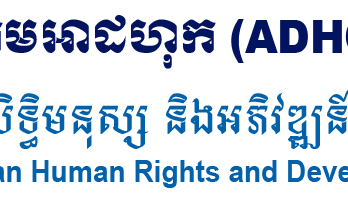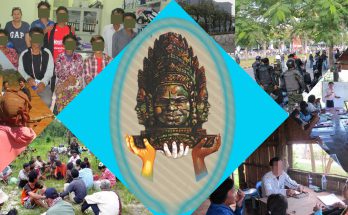Report
A TURNING POINT? LAND, HOUSING AND NATURAL RESOURCES RIGHTS IN CAMBODIA IN 2012
EXECUTIVE SUMMARY
Whereas 2011 had seen a sharp increase in the number of Economic Land Concessions (ELCs) granted by the Royal Government of Cambodia to private companies, in 2012 conflicts became more acute and protests multiplied. The government showed that it had understood the seriousness of the situation by taking initiatives aimed at resolving land disputes, addressing some of the issues related to ELCs and granting thousands of land titles to rural families. However, some of the most pressing concerns about the overall pressure on land, landlessness, land tenure insecurity, lack of law enforcement, power abuses, and encroachment on livelihoods and natural resources remained unaddressed.
The Reality: ELCs, SLCs, Land Disputes, Forced Evictions and Natural Resources
As of late December 2012, the Royal Government of Cambodia had granted or reserved at least 2,657,470 hectares of land to private companies under the Economic Land Concession scheme. This represents a 16.7 % increase from 2011. In 2012 alone, the government issued 66 sub-decrees reserving 381,121 hectares of land (including 108,524 hectares transferred from state public property to state private property) for ELCs, despite the announcement of a moratorium on the granting of Economic Land Concessions. The newly granted concessions and land re-classifications mostly affected protected areas.
Many ELCs have been approved despite substantial breaches of legal requirements. People living in concession zones are generally ignorant of basic information about the concessions, which points to a systematic failure by relevant institutions to inform the public about projects. Furthermore, private companies covet land which should have been protected in the first place, such as protected areas and indigenous land. Overall, oversight of concessions has been weak.
In 2012, the government granted 38 Social Land Concessions (SLCs) covering 100,790 hectares—more than twice the area granted under the SLC scheme in 2011 and one fourth of the area granted under the ELC scheme in 2012. This may indicate a change in policy, for SLC figures were negligible prior to 2012. However, out of 38 newly granted SLCs, 13 gave rise to conflicts. Corruption, mismanagement and serious abuses have been reported in relation to SLCs, which state authorities have failed to properly investigate. Today there is concern that measures taken to implement the SLC policy could actually worsen the situation of vulnerable families, aggravating landlessness and fueling land conflicts. People evicted or abused because of SLCs lose on all counts, as they are excluded from the very programs which should address their grievances.
In 2012, ADHOC handled 70 cases of land disputes affecting a total of 101,408 hectares and 10,689 families. In addition, ADHOC followed up on 62 unsolved cases of land conflicts left over from previous years. The most affected provinces, in terms of number and intensity of land disputes, were Battambang, Kampong Cham, Kampong Thom, Koh Kong, Kratie, Mondulkiri, Rattanakiri and Siem Reap.
Hundreds of communities across Cambodia have expressed their concern over the fact that they have been denied the right to register the land they legally occupy. As a consequence, they are facing eviction. Authorities at all levels have favored business interests over the recognition of people’s legitimate rights by referring to the latter as “squatters” or “new-comers” and using the development narrative to illegally evict them.
In most cases, the authorities have failed to comply with legal requirements concerning evictions and resettlement. The adoption of an Evictions Act and a National Housing Policy would be crucial to enhancing due process and security of tenure. They could allow the authorities to devise a strategy to address the issues of landlessness and informal settlements and to set out human rights safeguards in accordance with international standards. As of today, evictions in Cambodia continue to illegally occur as a first, not last, resort.
Despite environmental regulations and the official moratorium on logging, Cambodia’s natural resources are fast disappearing. Large tracts of forests have been affected by land concessions and smaller scale exploitation and logging. Indigenous peoples are particularly threatened.
The land situation is becoming critical. Citizens and communities are more and more aware of their rights and increasingly demand justice and accountability. Yet land is scarce and the authorities fail to uphold citizens’ rights. If the current problems are not addressed as a matter of priority, social stability may be at stake.
Adverse Effects and Consequences
An ever-increasing percentage of the Cambodian population is landless. Successive land titling programs have failed to address the needs of the Cambodian citizens who are most in need of land tenure security, i.e., those who live in informal settlements and disputed areas, as well as indigenous people. The question now is, where will Cambodia find enough land for the next generation, given that almost half the arable land is in the hands of private concessionaires, leased for up to 99 years?
Agro-industrial development and gradual increases in agricultural productivity are possible, notably through well-managed and well-monitored land concessions. However, smallholder agriculture with enhanced security of tenure would reduce poverty faster. The change of status currently experienced by many Cambodians (from farmers to wage-laborers) bears close resemblance to nineteenth-century European economic processes involving rural exodus and the transformation of a large part of the peasantry into landless wage-laborers. The government has been using migration as a pressure valve, exporting Cambodia’s cheap, unskilled labor force to neighboring countries.
The livelihoods and cultural rights of non-indigenous and indigenous people alike have paid a high price to development policies. In general, communities have not been consulted prior to the implementation of projects and have been left without any recourse in front of the fait accompli. Illegal logging, land concessions and large infrastructure projects continue to adversely impact natural resources. Primary forests such as Prey Lang are endangered, which could have tremendously negative effects on wildlife and biodiversity. Fisheries and water are also threatened, due to increased pollution and exploitation.
The current policies and practices are unsustainable. Today there is concern that protected areas (including primary forests and wildlife reserves) are fast disappearing and that there is not much arable land left for agricultural or agro-pastoral purposes.
Conflict Resolution
On paper there exist many means of settling disputes related to land and housing rights, including mediation, administrative bodies, and the court system. In practice, formal conflict resolution processes and institutions are often put aside or do not play their role. Conflicts often come to an end because the weaker party is threatened, harassed or forced to accept sub-standard compensation. The chief factors influencing land dispute settlement are the ability of the stronger party to the conflict to intimidate the weaker; to monopolize support from various public authorities; to act with impunity; and to manipulate the judicial system. Many people lack access to effective remedies and do not trust the courts, which favor rich, well-connected individuals and companies over poor people.
In 2012, rights workers witnessed a crackdown on peaceful protests and increased harassment of land and housing rights activists. On several occasions community empowerment meetings organized by civil society organizations were disrupted. What is even more concerning, violence and threats of violence are increasingly being used against community representatives as well as land and housing rights workers and activists.
An “infernal trio” of criminal charges (incitement, defamation and disinformation) has served to intimidate and harass Human Rights Defenders. Against the letter and spirit of criminal law, the courts have used pre-trial detention as a rule (not the exception) and detained people in order to break their will. In 2012, 232 people were arrested in relation to land and housing issues—a 144% increase from 2011. As of 31 December 2012, 38 were still in prison and 50 were at large. Several high profile cases, such as the trials of Mam Sonando and Boeung Kak and Borei Keila representatives and the killing of Chut Wutty, have taken their toll on human rights work. Fear is now pervasive, as the judicial system has consistently supported the government’s views and leveled trumped-up charges against activists. As a consequence, it is increasingly dangerous to represent communities and to defend the land, housing and natural resources rights of Cambodian citizens.
Cambodian courts are strong with the weak and weak with the strong. The impunity related to power abuses, the lack of law enforcement and lack of independence of the judiciary damage the reputation of Cambodia. The authorities cannot expect to resolve the land crisis this way.
Government Initiatives in 2012
On 7 May 2012, Prime Minister Hun Sen announced the issuance of a directive instituting a moratorium on the granting of new ELCs and enforcing the so-called “leopard-skin” policy. Directive 001 also called for a review of all existing concessions in order to check their compliance with relevant laws and regulations.
ADHOC welcomes this initiative, which was much needed. Nevertheless, an important loophole exists within the moratorium. ELCs that were under consideration when the freeze was announced are excluded from its application. In fact, ADHOC found that 33 ELCs had been granted since 7 May 2012, including as many as 13 in June and 10 in August. (From September to December 2012, only 4 new ELCs were granted.) If the government does not disclose information on exactly how many ELCs were in the pipeline on 7 May 2012, independent observers may question its political will to mitigate the effects of the ELC policy. The granting of additional concessions despite the moratorium would mean that promises made to private companies are more important than promises made to the Cambodian people.
On 14 June, the Prime Minister announced his intention to launch a new, accelerated land titling program to be implemented by youth volunteers in charge of demarcating people’s land. As of 22 December 2012, 71,220 land titles had been delivered and the volunteers had demarcated 333,275 plots covering 433,987 hectares.
ADHOC welcomes this development. However, since disputed areas have been left outside the scheme, people who are most in need of land titles will not receive them. Yet, recognition of possession rights (in accordance of the Land Law) could have been included in the program, in addition to land demarcation. This would have truly enhanced land tenure security by addressing the needs of people living in informal settlements or in areas potentially affected by development projects. The scheme does not address the situation of indigenous communities either. Reports ADHOC received from several of its provincial offices indicate that members of indigenous communities are being pressured into accepting private land titles instead of collective ones.
Initiatives of the executive branch that are aimed at providing land titles to rural families and protecting their land against encroachment are welcome but insufficient. They do not address the needs of those people and communities who are most in need of land titles. With significant international technical and financial assistance, the government will have no excuse if it does not address the grievances of those who are most in need of land tenure security.
* * *
2012 could be a turning point for land and housing rights in Cambodia. Recent government initiatives amounted to recognition that something had gone wrong and that the land crisis had begun to threaten the country’s stability. In the next few years, an increasing percentage of land conflicts should be linked to land grabbing in urban and rural areas alike. Economic Land Concessions now cover a large percentage of Cambodia’s arable land, and the government will not be able to continue granting as many concessions as in the last few years. New ELCs may however be taken from protected areas, islands, or cancelled concessions, but fewer conflicts are likely to be related to these. Conversely, conflicts related to land grabbing are likely to go on, fueled by greed and impunity.
What is most needed now, in addition to strengthening the rule of law and reviewing development policies, is the recognition that Cambodia’s development has been unregulated. Powerful interests have benefited disproportionately from land arrangements and policies, whereas marginalized people and communities as well as the country’s natural resources have borne the burden of change.
The government does not have a monopoly over the definition of development. Critical voices must be allowed to raise concerns about development projects and their adverse effects on the already poor, marginalized sections of the population. A range of alternative choices are possible, such as assisting smallholder farmers. In the absence of a comprehensive strategy aimed at addressing structural issues— exclusion, injustice and power abuse in relation to land and housing—temporary government initiatives will only patch up the problems for a short period of time. The first step must be complemented by a second (and much more difficult) one: enforcing existing laws and enhancing security of tenure for all—not just for those who live in non-disputed areas. The government now has a clear choice to make.
Mr. Latt Ky, Head, Land and Natural Resources Rights Program: 012 828 411 (Khmer, English)
Mr. Nicolas Agostini, Technical Assistant: 078 405 024 (English, French)




